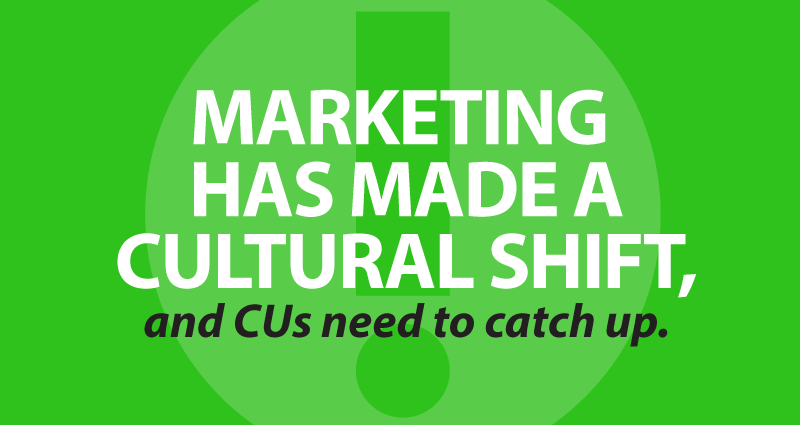
First you have to know what you don’t know
What you don’t know can hurt your credit union’s future. Because the world has been changing even if you haven’t.
Your 3-car garage in the suburbs isn’t even on the radar of young, potential members that prefer to live in a city where they won’t ever need a car, not to mention a space to park it.
Meanwhile, online retailers are buying brick and mortar locations from the stores they have been replacing, while insurance and software companies have gone into banking, lending directly to consumers.
How soon will it be before Alexa and Siri can pay bills upon command, or send birthday money from Grandma’s account to Brittany’s mobile? Probably not very long, since the number of users of conversational messaging apps (WhatsApp, Messenger, WeChat, Viber) have already surpassed those using social media apps (Facebook, Instagram, Twitter, LinkedIn).
Marketing has made a cultural shift, and credit unions need to catch up.
Consumers are in charge, not companies. People pick their own media, choose who and what they pay attention to, when. Brands need to be ready for the moment to fit into people’s lives, not expect to be able to choose those moments when it is convenient.
This reality is going to take some painful process shifts for credit unions as well. You can no longer expect to slap a slightly lower rate on an auto loan, sit back, and wait for the loans to roll in. No stacks of paper forms to be filled out, or waiting for days to get credit approval when non-banks can accomplish it in minutes. You need to be able to solve problems and instantly deliver what is wanted in a fast, frictionless way.
That’s why your website needs to be the hub of your marketing universe.
As your most-visible, 24/7 marketing tool, your website is critical to your brand image. Potential members will check your website first, long before they will ever consider taking out a loan or opening any accounts. Not only does your site need to look good, it needs to speak to that audience, telling your story in a way that allows them to see themselves as members & owners of the CU.
Your website should also be the hub of your marketing and branding – connecting social with traditional media, boosting member service and attracting new members, promoting products and maximizing your marketing budget. By inviting clicks and driving site visits via each component, you have a much better chance of explaining why your offer is the better option, answering questions and moving visitors through the sales process while you are tracking results that will help you improve the bottom line of your next campaign.
Every component in your marketing needs to use one brand voice.
Take a look at your website, marketing promotions, social media, newsletters, etc. Is there any kind of consistency to the messages? Or does it come across as a lot of different voices speaking at once?
When the voice of your social media sounds nothing like the rest of your marketing, you’ve got a problem. When your website is maintained and managed by IT instead of Marketing, you’ve got a problem. When your tellers have no idea what your marketing emails contain, you have yet another problem.
Members and potential members are looking for a financial institution that “gets” them. Building this kind of consistent, reputable brand voice takes coordination between departments and individuals, in order to ensure that everything you put out there presents your credit union in a unified way.
- Are you scared yet? - October 22, 2024
- OMG! Who really IS our competition?!? - September 24, 2024
- Do 5-star ratings really mean anything? - August 27, 2024
